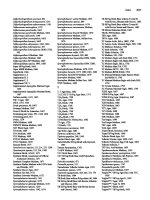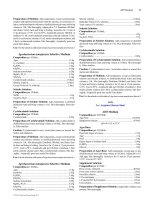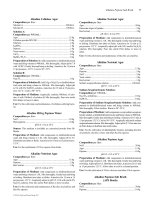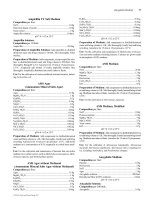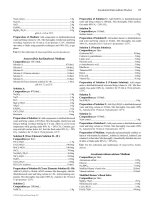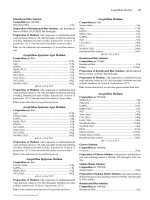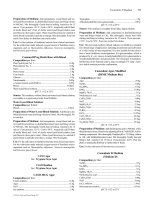Handbook of Small Electric Motors MAZ Part 9 doc
Bạn đang xem bản rút gọn của tài liệu. Xem và tải ngay bản đầy đủ của tài liệu tại đây (2 MB, 147 trang )
CHAPTER 3
MECHANICS AND
MANUFACTURING METHODS
Chapter Contributors
3.1
3.1 MOTOR MANUFACTURING PROCESS
FLOW*
The basic manufacturing processes for electric ac and dc motors are shown in this
section. Within each process, there are significant variables, each depending upon
the manufacturing equipment, size and variety of the parts, electrical efficiency
requirements, and economics. Each one of these process variables is described in the
following text.
3.1.1 AC Motor Manufacturing Process Flow
Figure 3.1 illustrates a basic ac motor manufacturing process flow. The first step is
producing laminations.These laminations are separated into rotors and stators.The
stator laminations, shown in Fig. 3.2,are then stacked into a core, and copper and/or
aluminum wire is wound into the core, producing a wound stator core. An outer
housing of some type is produced, and that is then wrapped around the wound sta-
tor core, making a wound stator assembly.The wound stator assembly is then sent to
motor assembly.
Larry C. Anderson
Axis SPA
John S. Bank
Warren C. Brown
Peter Caine
John Cocco
Phil Dolan
Leon Jackson
Roger O. LaValley
Bill Lawrence
NMB Corporation
Stanley D. Payne
Derrick Peterman
Karl H. Schultz
Chris Swenski
Harry J. Walters
Alan W. Yeadon
William H. Yeadon
* Sections 3.1 to 3.9 contributed by Karl H. Schultz, Schultz Associates, except as noted.
The rotor laminations in Fig. 3.3 are also stacked and then aluminum die cast into
a rotor casting, shown in Fig. 3.4.A shaft is then produced, and this is assembled into
the rotor, making it a rotor assembly, shown in Fig. 3.5. The rotor assembly is sent to
motor assembly.
Two end frames are produced and sent to motor assembly.
At the final operation, the wound stator assembly, rotor assembly, two end
frames, and miscellaneous parts are assembled into a complete motor. The motor is
then tested, painted, and packed for shipment.
3.2 CHAPTER THREE
FIGURE 3.1 Ac motor manufacturing process flow.
FIGURE 3.2 Stator laminations.
3.1.2 DC Motor Manufacturing
Process Flow
The basic dc motor manufacturing pro-
cess is illustrated in Fig. 3.6. Like ac
motors, the first step is producing lami-
nations for the pole piece and arma-
ture. The pole-piece lamination is
stacked with several other components
into a pole piece assembly. The pole
piece on dc motors may be of solid
steel, as shown in Fig. 3.7. A housing is
produced, and when the pole pieces are
inserted, it becomes a frame and field
assembly, shown in Fig. 3.8. This frame
and field assembly is then sent to motor
assembly.
Brushes, with other components, are
assembled into a brush assembly, as
shown in Fig. 3.9, and this is then assembled on the frame and field assembly.
The armature lamination is stacked into a core, which is then assembled onto a
shaft, and copper wire is inserted or wound onto the core. The coils may be con-
nected to the commutator as they are wound, as in Fig. 3.10, or connected after the
coils are inserted into the core and shaft assembly, as in Fig. 3.11.This is a completed
armature assembly which then goes to final motor assembly.
The frame and field assembly, armature assembly, and miscellaneous parts are
then assembled into a complete motor, as shown in Fig. 3.12. The motor is then
tested, painted, and packed for shipment.
MECHANICS AND MANUFACTURING METHODS 3.3
FIGURE 3.3 Rotor laminations.
FIGURE 3.4 Rotor casting.
3.4 CHAPTER THREE
3.2 END FRAME MANUFACTURING
The basic purpose of an end frame, sometimes denoted an end bell, end shield, or
bracket, is to contain the shaft bearings and support the rotor assembly. It will also
act as a heat transfer device. On open motors, the end frame will have slots for air to
pass. On enclosed motors, the end frames will be solid, with no openings. A variety
of end frames are shown in Figs. 3.13, 3.14, and 3.15.
Like housings, end frames come in cast-iron, steel, zinc, or aluminum castings.
Cast-iron castings are usually found on motors of 3 hp and larger. The service
application is in the industrial market where severe conditions may exist. Materials
are usually of about 30,000 lb/in
2
tensile strength and are free machining.The typical
sequence of operations is a two-machine cell—a computer numerically controlled
(CNC) machine prepares the bearing bore and end frame diameter, and a manual
drill is used to prepare the holes for the housing attachment.
The steel material is usually SAE 1010 to 1020. This type of end frame may be
found on all types and sizes of motors.A coil is processed through a stamping press,
and each part is drawn into form as a stamping. This is usually a progressive die
operation.
A self-aligning bearing is installed and lubricant is applied. Then the bearing is
sized for the only machining process.
Zinc or aluminum end frames are found on most motor types and sizes and gen-
erally are castings. End frames are usually cast in a horizontal die caster. Because of
its density, zinc is usually limited to end frames for motors 3 in in diameter or less. If
the parts are small enough, more than one part is made at one time.This depends on
the part and machine sizes.Also, on motors above
1
⁄4 hp, a steel bearing insert is usu-
ally die cast in the part. Following the die casting and part cooling, the part is
trimmed. Many manufacturers have installed robots for this operation because of
the heat and environmental conditions.
FIGURE 3.5 Rotor assembly.
FIGURE 3.6 DC motor manufacturing process flow.
3.5
3.6 CHAPTER THREE
FIGURE 3.7 Solid steel pole piece.
FIGURE 3.8 Frame and field assembly.
MECHANICS AND MANUFACTURING METHODS 3.7
FIGURE 3.9 Brush assembly.
FIGURE 3.10 Winding a commutator.
3.8 CHAPTER THREE
FIGURE 3.11 Core and shaft assembly.
FIGURE 3.12 Complete motor.
MECHANICS AND MANUFACTURING METHODS 3.9
FIGURE 3.13 End frame.
FIGURE 3.14 End frame.
The bearing bore and housing end frame diameter of the end frame are then
machined. This is done on either a CNC lathe or a special automatic machine,
depending on size and volume.
Some very small motors use an oil-soaked wick, as seen in Fig. 3.14, for lubrica-
tion.This is inserted after machining.
3.3 HOUSING MATERIALS AND
MANUFACTURING PROCESSES
Housings, also known as frames, come in all types of materials and configurations.
Basically, the housings are made in the same way for both ac and dc motors. The
basic purpose of the housing is to cover the stator or pole-piece assembly, provide
heat transfer and protection, provide a location for mounting the end frames, and
serve as an attachment for other components, such as outlet boxes and lifting
hooks.
3.3.1 Materials and Configurations
The housings come in cast iron; in rolled, wrapped, and tube steel; and in both cast
and extruded tube aluminum.
Cast Iron. Castings are usually found on motors of 3 hp and larger. The service
application is in the industrial market where severe conditions may exist. Materials
are usually of about 30,000 lb/in
2
tensile strength and are free machining.
In most cases, the mounting feet are cast as part of the housing.
3.10 CHAPTER THREE
FIGURE 3.15 End frame.
Steel. As mentioned, steel housings come in several configurations—rolled,
wrapped, and tube. The material is usually SAE 1010 to 1020. This type of housing
may be found on all types and sizes of motors.
Aluminum. This material is also found on most motor types and sizes. The cast
housings may be produced for a size as large as NEMA 360 but are usually not found
on motors rated below 3 hp.
The tubing may be found on the smallest motors up to about 25 hp.The material
is usually SAE 6061.
3.3.2 Manufacturing Processes
Cast Iron. The typical sequence of a cast iron operation is as follows:
1. Machine and drill the mounting feet to be used as a locator for further machining
operations.
2. Bore the inner diameter (ID).
3. Turn the end frame registers (optional—sometimes done as a wound stator
assembly).
4. Drill and tap for the end frame attachment.
5. Mill for the outlet box attachment.
These machining operations can be completed on either manual machines or
CNC machining centers. Usually machine-tool cells are incorporated.
Rolled Steel. A coil is processed through a stamping press and the shape is a flat
form. This piece is then formed around a mandrel and welded. In some cases, the
weld is a straight butt weld. In other cases, the rolled end attachment is interlocked
mechanically with several weld beads.
The housing is then machine-faced to length. Next, a stamped mounting base is
welded to the housing.
There are both highly automated and semimanual machines for this process.
Wrapped Steel. The manufacturing processes are the same as for a rolled housing,
except that the stator core is used as the mandrel.
Tube Steel. A drawn-over-mandrel (DOM) tube or a hot-rolled seamless tube is
processed in the following manner.
DOM. Cut to length, machine end frame diameter (optional—may be done as
a wound stator assembly), and weld mounting feet.
Seamless tubing. Cut to length,machine end frame diameter (optional—may be
done as a wound stator assembly), and weld mounting feet. Depending on the
condition of the bore, it may have to be machined.
Aluminum Castings. Most aluminum castings are produced as a complete housing
with mounting feet. These are machined like cast iron and with the same type of
equipment. Some, however, are cast over a stator core.This process requires machin-
ing like cast iron, except that the bore is not machined.
MECHANICS AND MANUFACTURING METHODS 3.11
Aluminum Tubing. The material is cut to length. Sometimes the end housing
diameter is machined prior to stator core assembly. The mounting feet are then
welded or screwed to the housing.
3.4 SHAFT MATERIALS AND MACHINING
3.4.1 Shaft Materials
Most motor manufacturers use SAE 1045 in either cold-rolled or hot-rolled steel
(CRS or HRS). Other materials include sulfurized SAE 1117, SAE 1137, SAE 1144,
hot-rolled SAE 1035, and cold-rolled SAE 1018. A ground stock of any material is
used on special CNC Swiss turning machines.
Generally, the cold-rolled and sulfurized steels will cost about 15 percent more
than HRS and will machine better. Machining trials need to be performed in order
to justify the extra cost. Since all shaft-turning machines perform differently, there is
no established material or machining practice.
Obviously, the hot-rolled plain carbon steel, on a cost-per-pound basis, is cheaper
than cold-rolled sulfurized steel. But there are tradeoffs.The hot-rolled material has
to be sized larger than cold-rolled because of the lack of outer diameter (OD) con-
trol in the rolling process. A manufacturer has to evaluate whether the larger-size
and lower-material-cost hot-rolled bar stock is more or less costly than cold-rolled
bar stock.Also, the hot-rolled material, by the very nature of its processing, has hard
and soft spots, residual stresses, voids, and other material deficiencies, making
machining more difficult. Again, machine trials need to be conducted to obtain the
best cost option between CRS, HRS, nonsulfurized, and sulfurized materials.
Because of the difficulties with HRS, most motor manufacturers will use sulfur-
ized CRS.
3.4.2 Machining Operations
Most manufacturers saw, shear, or turn the shaft length off the original bar stock.
Sawing is done with a band saw, machine back saw, or rotary saw, and the mate-
rial is cut either as a separate piece or in bundles.
One process, to eliminate the saw-cut kerf material, is a shear cutoff process. It is
very fast and noise has been eliminated. However, this meets with mixed results. In
the shearing process, the end of the bar is deformed—the top of it is formed down-
ward and the bottom has a burr,as illustrated in Fig. 3.16.This deformation has to be
removed in the face-and-center operation, which is sometimes difficult and causes
excess tool wear.
3.12 CHAPTER THREE
burr end
FIGURE 3.16 Shear cut-off process.
The third option is to cut off the shaft bar in a bar-turning machine. The bar-
turning machine will complete the shaft diameter machining, and as a last operation
a cutoff tool will remove the shaft from the bar.
Nearly all shafts for motors larger than
1
⁄4 hp have to be faced and centered for
future machining operations. This operation is usually completed on one machine
with a special face-and-center tool.
Both ends of the shaft are centered to provide a tool location in the lathe turning
operation and in balancing as a rotor assembly. Facing is also done in order to pro-
vide a more precise length in turning and when face drivers are used in the turning
operation.
Many motor manufacturers combine the bar cutoff and face-and-center opera-
tions.
Most motor manufacturers now use CNC turning machines because of their
quick setup changeover capabilities, capability of completing a shaft in one opera-
tion, and ability to precisely turn a diameter to 0.0005-in tolerance and meet the sur-
face finish requirements.
On motors greater than
1
⁄2 hp, the bearing journal tolerances are generally 0.0005-
in or higher. The ability to turn bearing journal diameters to a 0.0005-in tolerance
has eliminated the subsequent grinding operation.
Some motor manufacturers that produce shafts larger than 2 in (3 hp and up) use
a retractable jaw chuck in combination with a face driver, rather than a face driver
alone, in order to maximize the machine horsepower yet provide the necessary pre-
cision.This type of chuck also works well on hot-rolled bar steel because it provides
better clamping of the bar than do face drivers. The chuck jaws retract under the
semifinish turning operation to allow turning under the jaws. Then the CNC
machine completes the finish turning to size using the face drivers.
Most motor manufacturers combine keyway milling (on a manual machine) with
the CNC lathe in a one-person cell.
Some motor manufacturers started incorporating CNC Swiss turning machines
when they became available in the mid-1980s.These machines can machine a bar up
to about 2 in in diameter and hold tolerances to 0.0003 in. They incorporate com-
plete turning, including keyway milling, plus other special features such as threading
and grooving. The process helps assist flexibility in short runs and in completing
parts of extensive complexity. However, these machines require centerless ground
stock, which is more expensive than CRS or HRS.Again, the economics will dictate
the method of operation and equipment.
If the bearing journals require a size tolerance better than 0.0005 in, a separate
grinding operation is usually required.
Other machining options are the use of manual multispindle machines for cutoff
and turning and the use of grinders for grinding bearing journals and seal diameters.
This option is usually used for shaft diameters 1 in and smaller. A high-volume
option for 1-in and smaller shafts is a dedicated transfer line which uses ground bar
stock.
Some motor manufacturers, particularly those that produce sizes of 5 hp and up,
finish-machine the bearing journals and rotor diameter as a rotor assembly. This
operation produces the best possible concentricity between the bearing journals and
rotor diameter.
Few motor manufacturers have had success with postprocess gauging with feed-
back size compensation in the bearing journal finish-machining operations. How-
ever, this is expensive and is not always accurate because the part has to be clean.
Some people believe that once a shaft is removed from the turning operation,
one can not use the centers for location in future operations. However, the method
MECHANICS AND MANUFACTURING METHODS 3.13
used is to set up a finished shaft (with or without rotor) in a lathe to indicate the
drive end and both journals. If the output end is within 0.0005 in of true inner radius
(TIR) and both journals with respect to each other are within 0.003 in TIR, turn the
rotor OD as is. If not, adjust centers to get the acceptable TIR.
3.5 SHAFT HARDENING
In many instances it is desirable to harden shaft materials. Harder shafts take longer
to wear out than softer shafts. Shafts that are too hard become brittle and subject to
fracturing. The exact hardness required depends on the intended use of the motor
and the life required. Generally, when the shaft is used with a sleeve bearing system,
the shaft needs to be somewhere between 35 and 55 on the Rockwell C scale. The
ability to harden a shaft depends on the material being used and the hardening pro-
cess (see Table 3.1).
3.14 CHAPTER THREE
TABLE 3.1 Common Shaft Material Characteristics
Material
Carbon steels Tensile strength, (lb/in
2
) Hardenable Characteristics
1018 62,000 Carburize Will corrode
1050 105,000 Heat treat Will corrode
1095 140,000 Heat treat Will corrode
1117 71,000 Carburize Good machinability
4140 148,000 Heat treat Good machinability
Stainless steels
303 90,000 No Nonmagnetic—high
wear when used with
bronze bearings
416 120,000 Yes Free machining
440 260,000 Yes Corrosion resistant
Case Hardening.* Case hardening is a process of surface hardening involving a
change in the composition of the outer layer of an iron-base alloy followed by
appropriate thermal treatment. In order to harden low-carbon steel it is necessary to
increase the carbon content of the surface of the steel so that a thin outer case can
be hardened by heating the steel to the hardening temperature and then quenching
it. The first operation is carburizing to impregnate the outer surface with sufficient
carbon; the second operation is heat-treating the carburized parts so as to obtain a
hard outer case and at the same time give the core the required physical properties.
The term case hardening is ordinarily used to indicate the complete process of car-
burizing and hardening.
Some of the most common processes are described here.
Carbonitriding. A case-hardening process which causes simultaneous absorp-
tion of carbon and nitrogen by the surface.
Carburizing. A process in which carbon is introduced into a solid iron-base
alloy while in contact with a carbonaceous material. Carburizing is frequently fol-
lowed by quenching to produce a hardened case.
* This subsection from Machinery’s Handbook 23, Revised Edition, Industrial Press,New York, 1988,p. 441.
Cyaniding. A process of case hardening an iron-base alloy by heating in a
cyanide salt.
Nitriding. A process of case hardening in which an iron-base alloy of special
composition is heated in an atmosphere of ammonia or while in contact with
nitrogenous material.
3.6 ROTOR ASSEMBLY
The rotor assembly consists of a die-cast rotor and a shaft. Both components may be
completely machined and assembled, partially machined and assembled, or a com-
bination of both.The reasons for the various rotor assembly options are economics;
size; unit volume; and desired electric motor efficiency, which relates to concen-
tricies and the air gap between the rotor and stator.
3.6.1 Basic Assembly Process
The most efficient and economic assembly method is to assemble a nonmachined die-
cast rotor with a completely machined shaft. Probably the most economical assembly
method is to mechanically press-fit a shaft onto the rotor. This process can be hand
operated or completely automated, with the process determined by unit volume and
the variety of rotors and shafts. Less variety and smaller sizes lend themselves more
to automation. Some companies have completely automated this assembly process.
Thus, in the basic process flow, illustrated in Fig. 3.17, a completely machined
shaft and a nonmachined die-cast rotor are processed by being mechanically press-
fit. This process is used for many very small motors. The resulting rotor assemblies
probably will not have the best tolerance concentricities, thus affecting motor effi-
ciencies and noise—but, as mentioned, they will be the least costly.
3.6.2 Rotor Machining
ID Machining. Cast-aluminum rotors tend to be banana-shaped due to the heat
and sometimes due to lack of internal support in the casting process.Also, rotor lam-
inations need to be rotated prior to die-casting in order to eliminate or reduce the
lamination material camber, which will cause a banana shape; this is more prevalent
in the heating and shrinking process than in the press-fit process. Part of the rotor
core bore curve is imparted to the shaft. The rotor core is then turned to obtain the
proper air gap. In service, the rotor heats up the aluminum bars, which expand more
than the steel core, thus relieving the axial clamp and imparting the curve to the
shaft. This can cause unbalance, increase slot-pitch noise, and generate structure-
borne noise because of vibration.This effect is greater for long cores.
MECHANICS AND MANUFACTURING METHODS 3.15
FIGURE 3.17 Rotor assembly process.
To solve this banana-shape problem, manufacturers ream, bore, or broach the
core ID prior to shaft assembly. This surface then can be used for location when
machining the rotor OD if required.
OD Machining—Rotor Only
Turning. Rotor OD machining is usually done on an expanding ID arbor. This
allows turning the OD to the average bore diameter. If the rotor bore is machined
prior to OD machining and used as a locator, there will be excellent concentricity
between the bore and the OD. This possibly might eliminate machining the rotor
OD when attached to the shaft, but laminations with the OD punched to size are
needed.
Grinding. Rotors that have their ODs cut with a tool will have OD smearing.
This causes lamination shorting at the air gap and will reduce efficiency and cause
hot spots. Plunge grinding, with or without a shaft attached, will reduce smearing to
a minimum. Some hermetic motor manufacturers use a centerless belt grinder to
size and clean up the OD only. Sometimes, depending upon the application, the OD
will be used as a locator to machine the ID.
OD Machining—Rotor on Shaft. There are several schools of thought on how to
finish-machine the rotor and shaft combination. One method is to allow stock on the
bearing journals and then turn the rotor OD and journals in the same setup. In some
CNC machines, the journals can be finished to size (not better than 0.0004 in) and
finish [20 to 30 root mean square (RMS)] without grinding.This operation can also
be completed with a plunge grinder, but the labor content makes it expensive. Com-
pleting the bearing journals and rotor OD in one setup is probably the best opera-
tion for obtaining consistent air gap.
3.6.3 Electrical Efficiency Improvement Processes
Most motor manufacturers need to have better electrical efficiencies than that pro-
vided by the basic assembly process (Sec. 3.6.1), and the machining processes for
rotor assembly will affect the required efficiencies. This subsection examines many
of the various processes that will improve electric motor efficiencies.
Rotor Machining. Most manufacturers machine the rotor outside diameter and
shaft diameters after assembly, but there are other various ways to accomplish this
process. The major interest is to achieve
better electrical efficiencies. One must
have the best concentricity between the
shaft bearing diameters and the rotor
outside diameter while leaving an equal
amount of back-iron thickness. Back-
iron thickness is defined as the distance
between the rotor OD, which is the lam-
ination, and the aluminum die-cast slot,
as shown in Fig. 3.18.
Also, there is a concern that machin-
ing the rotor OD may “smear” the steel
laminations and aluminum die-cast materials. This smearing will reduce electric
motor efficiencies. In a turning operation, the cutting tools must be maintained in a
sharp condition.This rotor OD turning operation can be achieved as a separate part
or as a rotor assembly.
3.16 CHAPTER THREE
Back-iron
thickness
Slot
Lamination
FIGURE 3.18 Rotor back-iron thickness.
Rotor Grinding. Another process method to reduce smearing is to use a center-
less abrasive belt grinder to grind the rotor outside diameter (not as a rotor assem-
bly).The abrasive belt will not become loaded up with steel and aluminum as might
occur with a hard-wheel grinder. This centerless grinding process also guarantees
that the back-iron thickness will be uniform.
Lamination Punching. Some motor manufacturers punch the lamination to size,
thus eliminating any rotor OD turning. However, the lamination dies must be main-
tained and the process monitored continuously.
Process Options. Several process options are shown in Figs. 3.19a through 3.19e.
The optimally efficient process for electric motors is probably the one shown in Fig.
3.19e. Again, with the variety of machining options, a company must evaluate the
requirements for electric motor efficiency and economics.
3.6.4 Options for Attaching Rotor to Shaft
There are basically four options in attaching the rotor to the shaft: (1) press-fitting,
(2) heating and shrinking the rotor, (3) slip-fitting with adhesive, or (4) welding.The
MECHANICS AND MANUFACTURING METHODS 3.17
FIGURE 3.19 Options for optimum efficiency electric motor manufacturing process.
(e)
(d)
(c)
(b)
(a)
process selected is usually dictated by economics.These processes are discussed here
(see Fig. 3.20).
3.18 CHAPTER THREE
FIGURE 3.20 Rotor and shaft processing option.
Press-Fitting. The most basic and economical attachment process is pressing the
rotor onto the shaft. This is usually done in a vertical hydraulic press. The rotor is
placed in a holding fixture, and the shaft is placed into the rotor ID. Tolerance con-
trol of the rotor ID and the shaft OD must be maintained. Generally, the press fit
should be in the range of 0.001 in per inch of shaft diameter minimum.
If the press fit is too tight, the shaft may bend. If the press fit is too loose,the shaft
may turn on the rotor in application. Monitoring of the press hydraulic pressure dur-
ing the press fit will provide a quality assurance check (preventing too tight or too
loose a fit).
Usually the shaft rotor diameter will be upset in some manner—knurling, jab
blocking, etc.—in order to ensure a press fit.
Heating and Shrinking the Rotor. Another attachment process is heating the
rotor by induction or with some type of external heat source and dropping the rotor
onto the shaft.The heating process requires energy,and one must be concerned with
personnel handling hot parts. It also requires some in-process inventory in the rotor-
heating process. This process provides a greater tightness between rotor and shaft
than does press-fitting, plus it does not have the same potential for bent shafts as
does the pressing operation.
For common shaft rotor tolerances, the rotor should be heated to between 400
and 450°F (204 and 232°C), but not above 700°F (371°C), as this temperature will
start to affect the aluminum.
Generally, assembly of larger motors, over 5 hp, will use rotor heating because a
very large hydraulic press is required for press-fitting.
Section 3.6.5 gives example calculations for determining shrink-fit dimensions.
Slip-Fitting with Adhesive. The rotor ID and shaft OD are sized to allow a slight
slip fit of the rotor onto the shaft. It is usually on the order of 0.001 to 0.002 in of
clearance. The exact clearance is a function of the adhesive and must be adjusted in
accordance with the recommendations of the adhesive supplier. Parts must be clean
and free of lubricants before assembly.A drop or two of adhesive is put on the shaft.
It is then slipped into the rotor with a twisting motion. A fixture with a stop is nec-
essary for proper shaft location.After assembly, the adhesive is given time to cure.
Welding. On 5 hp and higher motors, some manufacturers weld bead the final
rotor-to-shaft attachment. Others use a key to ensure a locking condition.
Balancing. After the shaft and rotor are assembled, balancing is required. Most
balancing operations are done by setting the rotor assembly with the bearing jour-
nals on support rollers and rotating the assembly to determine the out-of-balance
condition in two planes.
There are two types of balancers, soft- and hard-bearing. Basically the difference
is that a soft-bearing machine operates below the suspension’s resonant frequency.
Hard-bearing balancers are generally easier to use, safer, and provide a rigid work
support.
Most balancing machines will determine the location and amount of weight that
needs to be applied. Some motor manufacturers add an epoxy weight to the rotor
core. However, a fast drying heat is required in order to speed up the hardening of
the epoxy. Others design the rotor end casts with protrusions so that weights (wash-
ers) may be added.Very few drill or machine out weight because this can affect elec-
trical efficiencies.
Balancing machines come in either manual- or automatic-load types,usually with
computer controls.
3.6.5 Shrink-Fit Calculation Examples*
1. Determine the temperature differential ∆T, °F (± from room temperature).
∆T =
(differential expansion)/(basic shaft diameter, in)
ᎏᎏᎏᎏᎏᎏ
coefficient of thermal expansion
MECHANICS AND MANUFACTURING METHODS 3.19
* Subsection contributed by Chris Swenski,Yeadon Energy Systems, Inc.
where the differential expansion is the total diameter change required. It includes
the inference fit plus the slip clearance.
Some common coefficients of thermal expansion are listed in Table 3.2.
2. Calculate the desired expansion and shrinkage to find temperature change
required for 1020 CRS, where the shaft OD is Ø1.2500 and the rotor ID is Ø1.2480.
These diameters give a 0.002-in interference fit. The minimum desired slip fit
clearance is 0.003 in, and the differential expansion is 0.005 in.
The temperature change ∆T required on these parts to give 0.005-in expansion is
calculated as follows.
∆T ==615.38°F (3.1)
A 615.38°F change in temperature is required. Therefore, the total temperature
would be 615.38°F plus ambient (72°F in this case). One could heat the rotor to
687.38°F (364.10°C). The shaft temperature could be reduced to shrink the shaft in
order to reduce the heat needed for expansion of the rotor.
For instance, cool the shaft to −75°F (−59°C), and heat the rotor to 540.38°F
(282.43°C) to get the required deferential expansion.
3. Another method is to use the maximum change in temperature to determine
differential expansion. The total possible change in temperature using dry ice at
−100°F (−73°C) to cool the shaft and an oven at 700°F (371°C) to heat the rotor is
800°F (444°C).
∆T = 800°F
= 0.0065 in shrinkage growth (3.2)
Differential expansion =∆T (coefficient of the thermal expansion) (shaft OD) =
(800°F) [0.0000065 in/(in ⋅∆°F)] 1.250 in = 0.0065 in
0.0065 in − 0.002 in interference = 0.0045 in clearance at these temperatures.
For practical purposes, one may use a dry ice temperature of −75°F and an oven
temperature of 650°F. This allows for the extremely fast warming of the shaft and
cooling of the rotor while assembling.
A minimum of 0.003 in clearance was calculated for all fits. The usual finished
interference between the parts ranges from 0.0005 to 0.003 in.
(Differential expansion)/(slot OD)
ᎏᎏᎏᎏ
0.0000065
0.005/1.2500
ᎏᎏ
0.0000065
3.20 CHAPTER THREE
TABLE 3.2 Coefficients of Thermal
Expansion for Common Materials
Coefficient of thermal
Material expansion, in/(in ⋅∆°F)
Common steel 0.0000065
Nickel steel 0.0000070
Cast iron 0.0000062
Aluminum 0.0000124
3.7 WOUND STATOR ASSEMBLY PROCESSING*
Wound stator assembly processing basically consists of attaching a wound stator
core into a housing. However, there are many different assembly processes, depend-
ing upon the housing material, the size, and the electrical efficiency requirements.
3.7.1 Steel Pressing
The steel housings are pressed over the wound stator core. Sometimes the mounting
base is welded or screwed to the housing before or after this operation. Usually a
final attachment is made either by welding beads or by pinning, which requires
drilling a hole into the wound stator core.
3.7.2 Cast-Iron Pressing
The cast-iron process, for motors up to about 25 hp, is the same as that used for steel
housings, for motors above 25 hp.The housing is heated. For motors above 25 hp, the
hydraulic press needed becomes very large, and the process is sometimes not eco-
nomical.
3.7.3 Heating and Shrinking
Almost all aluminum housings are heated and shrunk onto the wound stator core.
Usually, the housings are pinned to the wound stator core. The base is sometimes
welded or screwed to the housing before or after this operation.
3.7.4 Electrical Efficiency Requirements
The mounting of the end frames to the housing is crucial in maintaining the best air
gap (concentricies) possible. The end frame bearing housing is usually machined at
the same time as the housing attachment diameter (see Fig. 3.21).
MECHANICS AND MANUFACTURING METHODS 3.21
* Sections 3.7 to 3.9 contributed by Karl H. Schultz, Schultz Associates.
FIGURE 3.21 Mounting of end frame to housing.
In order to maintain the best possible concentricies for best air gap control, most
manufacturers machine the housing end frame diameter as a wound stator assembly,
locating off the bore (see Fig. 3.22).
3.8 ARMATURE MANUFACTURING
AND ASSEMBLY
Armature manufacturing and assembly require significant hand labor, although the
size and unit volumes will dictate the degree of automation. Following is the process
and manufacturing flow.
3.8.1 Armature Core Assembly
1. Stack laminations to proper length.Sometimes this is done by weighing the stack.
The outer end laminations are turned so that the burrs are on the inside. Two
stacks are made.
2. Place the two stacks in a press. Locate a machined shaft on top of the stack and
press into location.
3.8.2 Armature Coil Assembly
1. Insert insulation paper into the armature core lamination slots. This is done
either manually or automatically.
2. Insert armature coils (usually rectangular-shaped copper wire) into the armature
core lamination slots.This can be done manually or automatically.
3. Twist the ends of the armature coils. This requires a special machine.
4. Press the commutator onto the armature coil.
5. Press or stake the armature coil ends into the commutator.
6. Band the armature coil ends into the commutator.
7. Varnish.
8. Turn the commutator to achieve a very smooth finish.Sometimes a diamond tool
is used.
9. Braze the commutator ends.
3.22 CHAPTER THREE
FIGURE 3.22 Machine housing.
3.9 ASSEMBLY, TESTING, PAINTING,
AND PACKING
The final motor assembly, testing, painting, and packing process is as varied as the
other processes, depending upon the unit volume, size, and variety (see Fig. 3.23).
3.9.1 Assembly
Most very small motors up to about
1
⁄4
hp can be assembled automatically. Some are
assembled in as little as 5 s by highly automated equipment costing hundreds of
thousands of dollars. The success of high-volume automation is the quality of the
parts. Part quality that can not be controlled will jam the machine and cause poor
utilization.
Changeover from one motor size or configuration to another is not easily done
on a high-volume automated machine, although there have been strides in recent
years to provide for quick setup. High-volume automated assembly machines are
best run without changeover because they need to be kept running as much as pos-
sible in order to justify their cost.
In a line loader, the operator gathers various parts needed to assemble a particu-
lar motor (end frames, rotor assembly, wound stator assembly, and miscellaneous
parts) and places them on a tray, which moves down a conveyor to the assembly line.
The conveyor to the assembly line is controlled by an assembly operator, so the
motor parts may be called for as they are needed.
There are several assembly stations, and each operator takes parts from the tray
and completes their portion of the assembly. The operator then places that compo-
nent on the tray, and it moves to the next station. Sometimes this process is done on
a moving conveyor rather than trays.
Some low-volume or significantly sized motors are assembled in one-person cells.
The components are set on pallets and/or in racks for the assembly operator’s access.
Usually the operator will assemble the complete motor.
3.9.2 Testing
A variety of electrical and mechanical tests are usually completed on a motor before
shipping, some dictated by customer requirements. These tests can be any or all of
the following: input voltage regulation, full load, no load, inertial load, equivalent
circuit, locked rotor, low-voltage start, torque/speed curve, rotation direction, ac or
dc high potential, insulation resistance, surge/impulse, vibration, acoustic noise, and
temperature. Most test systems have preprogrammed menus so that the operator
does not need to input the data.
After the initial setup, the operator loads and secures the motor into the fixture,
makes the proper connections, and starts the test. All testing is automatically
sequenced. After the test is completed, the measured results are compared to pre-
programmed limits. The data is stored, printed, or transmitted as the user requires.
The operator can observe whether the motor has passed or failed and can take
appropriate action. Manual to completely automatic test equipment is available.
Sometimes mechanical tests are performed, such as for rotor assembly end play
and tight bearings. Noise tests are also conducted, and most motor manufacturers
enclose the entire test area in a sound booth so that any noise can be measured or
heard.
MECHANICS AND MANUFACTURING METHODS 3.23
Stator Lam
Wound Stator
Core
Wound Stator
Assembly
Assembly, Test,
Paint & Pack
Shell
Stator Lam
Rotor Cast
Rotor AssemblyShell
End shield
Misc. Parts
FIGURE 3.23 Assembly and testing.
3.24
3.9.3 Painting
Environmental regulations have largely restricted the type of paint that can be used.
Most manufacturers have changed to a water-base or powder paint and have auto-
mated the process. Meeting customer color requirements requires motor manufac-
turers to install equipment that can be quickly changed over.
Some manufacturers paint components before assembly to eliminate masking.
However, the components have to be handled properly in order to minimize mark-
ing at assembly.
3.9.4 Packing
Motors under
1
⁄4 hp are usually shrink-wrapped separately. Some have cardboard
bases for support. Some are put on a pallet and shrink-wrapped as a container.
Motors over
1
⁄4 hp are usually packed in cardboard boxes or on pallets. Most of the
packaging process can be automated as much as possible.
3.10 MAGNETIC CORES*
Stator core assemblies, shown in Figs. 3.24 and 3.25, are insulated stacks of lamina-
tions lined up to close tolerances. The laminations themselves can be held to toler-
ances within 0.001 in (±0.0005 in) on the OD and ID. However, they must be
assembled into a core in some fashion. Permanent-magnet motors have air gaps on
the order of 0.015 to 0.040 in per side. Induction motors have air gaps on the order
of 0.010 to 0.015 in. These gaps must be held very consistent to avoid performance
and noise degradation. There are many methods for assembling stacks of lamina-
tions. This section discusses some of the most common stacking methods with their
positive and negative attributes.
Loose armature, induction rotor, or outer rotor brushless dc motor laminations
may be pressed onto a sleeve or shaft. Other methods include heat shrinking, ring
staking, or adhesive bonding.
3.10.1 Welded Cores
The lamination stacks are generally fixtured off the stator bore and welded along
the OD of the stack. The tolerance is now a result of the welding fixture, which
allows for some shift in lamination placement. The eddy current core losses are
increased because the welding short-circuits to the laminations at the weld joints.
The core assembly may have to be machined to bring the OD back to an acceptable
dimension. Weld depth should be kept to a minimum, and welds should be posi-
tioned behind the poles or teeth. When possible, a laser weld is best in the cases in
which it provides adequate strength.
MECHANICS AND MANUFACTURING METHODS 3.25
* Sections 3.10 to 3.10.3 contributed by William H.Yeadon and Alan W.Yeadon,Yeadon Engineering Ser-
vices, PC.


